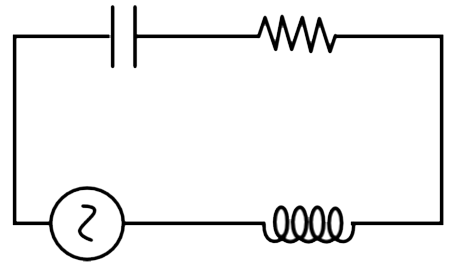Three stars each at mass m, moving in a circular orbit of radius or about a stationary central star of mass M. The three identical stars orbits in the same sense and are symmetrically located with respective each other (The centre of all stars lie in one plane). Considering gravitational force of all remaing bodies on every star, the time period of each of the three stars is
2π ⎷r3G[m+m3]
2π ⎷r3G[m+m√3]
2π√r3G[m+3m]
2π ⎷r3G[m+√3m]
The correct Answer is:B
Topper's Solved these Questions
- GRAVITATIONBOOK - AAKASH SERIESCHAPTER - GRAVITATIONEXERCISE - ADDITIONAL PRACTICE EXERCISE (LEVEL-II) LECTURE SHEET (ADVANCED) More than One correct answer Type Questions
1 Videos
- GRAVITATIONBOOK - AAKASH SERIESCHAPTER - GRAVITATIONEXERCISE - ADDITIONAL PRACTICE EXERCISE (LEVEL-II) LECTURE SHEET (ADVANCED) Linked Comprehension Type Questions
2 Videos
- GRAVITATIONBOOK - AAKASH SERIESCHAPTER - GRAVITATIONEXERCISE - ADDITIONAL PRACTICE EXERCISE (LEVEL-I (MAIN)) Straight Objective Type Questions
18 Videos
- GAUSS.S LAW BOOK - AAKASH SERIESCHAPTER - GAUSS.S LAW EXERCISE - PROBLEMS (LEVEL - II)
12 Videos
- GRAVITATIONALBOOK - AAKASH SERIESCHAPTER - GRAVITATIONALEXERCISE - EXERCISE -3
154 Videos
Similar Questions
A system consists of two stars of equal masses that revolve in a circular orbit about their centre of mass . Orbital speed of each star is v and period is T . Find the mass M of each star . (G is gravitational constant )
View SolutionA pair of stars rotates about a common centre of mass. One of the stars has a mass M and the other has mass m such that =2m. The distance between the centres of the stars is d ( d being large compare to the size of eithe star).
The period of rotation of the stars about their common centre of mass ( in terms of d,m,G) is
View Solution
Knowledge Check
A planet is revolving around a star in a circular orbit of radius R with a period T. If the gravitational force between the planet and the star is proportional to R−3/2, then
AT2∝R5/2BT2∝R−7/2CT2∝R3/2DT2∝R4A system consists of two stars of equal masses that revolve in a circular orbit about their centre of mass . Orbital speed of each star is v and period is T . Find the mass M of each star . (G is gravitational constant )
A2Gv3πTBv3TπGCv3T2πGD2Tv3πGA pair of stars rotates about their centre of mass One of the stars has a mass M and the other has mass m such that M=2m The distance between the centres of the stars is d (d being large compared to the size of either star) .
The period of rotation of the stars about their common centre of mass (in time of d ,m ,G) is .A√4π2Gmd3B√8π2Gmd3C√2π23Gmd3D√4π23Gmd3
A pair of stars rotates about their centre of mass One of the stars has a mass M and the other has mass m such that M=2m The distance between the centres of the stars is d (d being large compared to the size of either star) .
The ratio of kinetic energies of the two stars (Km/KM) is .
View SolutionTwo stars of mass M1&M2 are in circular orbits around their centre of mass The star of mass M1 has an orbit of radius R1 the star of mass M2 has an orbit of radius R2 (assume that their centre of mass is not acceleration and distance between starts is fixed)
(a) Show that the ratio of orbital radii of the two stars equals the reciprocal of the ratio of their masses, that is R1/R2=M2/M1
(b) Explain why the two stars have the same orbital period and show that the period
T=2π(R1+R2)3/2√G(M1+M2) .
View SolutionA star of mass M (equal to the solar mass) with a planet (much smaller than the star) revolves around the star in a circular orbit. The velocity of the star with respect to the center of mass of the star-planet system is shown below :

View SolutionA pair of stars rotates about their centre of mass One of the stars has a mass M and the other has mass m such that M=2m The distance between the centres of the stars is d (d being large compared to the size of either star) .
The ratio of kinetic energies of the two stars (Km/KM) is .
View SolutionA planet of mass m is moving around a star of mass M and radius R in a circular orbit of radius r. The star abruplly shrinks to half its radius without any loss of mass. What change will be there in the orbit of the planet ?
View Solution
